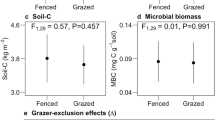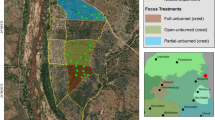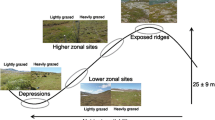Abstract
We used a long-term herbivore removal experiment where paired exclosure–open treatments were established at the Mpala Research Centre, Laikipia, Kenya, in 1999 to examine changes in soil nitrogen (N) at nutrient-rich glades and adjacent nutrient-poor bushland sites after almost two decades of herbivore removal. Glades in this landscape are created by large inputs of dung and urine from previous long-term corralling of cattle in an otherwise nutrient-poor matrix of woodland (bushland). We predicted (1) a net gain of soil nutrients at bushland sites (that is, inputs of nutrients > losses) and (2) a net loss of soil nutrients at glade sites (that is, inputs of nutrients < losses) following herbivore exclusion. As expected, soil N increased (by 28% after 17 years) with herbivore removal, but remained largely unchanged in the presence of herbivores at low-nutrient bushland sites. However, contrary to our expectations, soil total N in nutrient-rich glades also increased (+ 18%) when herbivores were removed, but declined when grazed (− 11%). Although the underlying mechanisms are unclear, we suggest that increased N fixation by Acacia spp., combined with increased canopy cover and associated tree leaf litter, resulted in elevated soil N following browser removal in low-nutrient bushland sites, while grazer-induced increases in the rate of N transformations between organic and mineral forms resulted in a more “open” N cycle (as evidenced by higher N mineralization rates and foliar N), with increased potential for N loss in gaseous forms, in grazed nutrient-rich glade sites. Grazers and browsers thus appear to affect the N cycle and create and reinforce heterogeneity in unique ways.




Similar content being viewed by others
References
Ahn PM, Geiger LC. 1987. Kenya soil survey - soils of Laikipia District. Kabete, Kenya: Ministry of Agriculture, National Agricultural Laboratories.
Andriuzzi WS, Wall DH. 2017. Responses of belowground communities to large aboveground herbivores: Meta-analysis reveals biome-dependent patterns and critical research gaps. Global Change Biology 23:3857–3868.
Assefa F, Kleiner D. 1998. Nodulation pattern and acetylene reduction (nitrogen fixation) activity of some highland and lowland Acacia species of Ethiopia. Biology and Fertility of Soils 27:60–64.
Augustine DJ. 2003. Long-term, livestock-mediated redistribution of nitrogen and phosphorus in an East African savanna. Journal of Applied Ecology 40:137–149.
Augustine DJ. 2010. Response of native ungulates to drought in semi-arid Kenyan rangeland. African Journal of Ecology 48:1009–1020.
Augustine DJ, Frank DA. 2001. Effects of migratory grazers on spatial heterogeneity of soil nitrogen properties in a grassland ecosystem. Ecology 82:3149–3162.
Augustine DJ, McNaughton SJ. 2004. Regulation of shrub dynamics by native browsing ungulates on East African rangeland. Journal of Applied Ecology 41:45–58.
Augustine DJ, McNaughton SJ. 2006. Interactive effects of ungulate herbivores, soil fertility, and variable rainfall on ecosystem processes in a semi-arid savanna. Ecosystems 9:1242–1256.
Augustine DJ, McNaughton SJ, Frank DA. 2003. Feedbacks between soil nutrients and large herbivores in a managed savanna ecosystem. Ecological Applications 13:1325–1337.
Augustine DJ, Veblen KE, Goheen JR, Riginos C, Young TP. 2011. Pathways for positive cattle–wildlife interactions in semiarid rangelands. Smithsonian Contributions to Zoology 632:55–71.
Augustine DJ, Wigley BJ, Ratnam J, Kibet S, Nyangito M, Sankaran M. 2019. Large herbivores maintain a two-phase herbaceous vegetation mosaic in a semi-arid savanna. Ecology and Evolution 9:12779–12788.
Bardgett RD, Wardle DA. 2003. Herbivore-mediated linkages between aboveground and belowground communities. Ecology 84:2258–2268.
Bates D, Mächler M, Bolker B, Walker S. 2015. Fitting linear mixed-effects models using lme4. Journal of Statistical Software 67:1–48.
Belsky AJ, Amundson RG, Duxbury JM, Riha SJ, Ali AR, Mwonga SM. 1989. The effects of trees on their physical, chemical and biological environments in a semi-arid savanna in Kenya. Journal of applied ecology:1005–24.
Birnie A, Noad T. 2011. Trees of Kenya: An illustrated field guide. Nairobi: Kenway Publications Ltd.
Blackmore AC, Mentis MT, Scholes RJ. 1990. The origin and extent of nutrient-enriched patches within a nutrient-poor savanna in South Africa. Journal of biogeography 17:463–70.
Bonnet O, Fritz H, Gignoux J, Meuret M. 2010. Challenges of foraging on a high-quality but unpredictable food source: the dynamics of grass production and consumption in savanna grazing lawns. Journal of Ecology 98:908–916.
Bubnicki JW, Churski M, Schmidt K, Diserens TA, Kuijper DP. 2019. Linking spatial patterns of terrestrial herbivore community structure to trophic interactions. ELife 8:e44937.
Cherif M, Loreau M. 2013. Plant–herbivore–decomposer stoichiometric mismatches and nutrient cycling in ecosystems. Proceedings of the Royal Society b: Biological Sciences 280:20122453.
Coetsee C, Stock WD, Craine JM. 2011. Do grazers alter nitrogen dynamics on grazing lawns in a South African savannah? African Journal of Ecology 49:62–69.
Craine JM, Brookshire ENJ, Cramer MD, Hasselquist NJ, Koba K, Marin-Spiotta E, Wang L. 2015. Ecological interpretations of nitrogen isotope ratios of terrestrial plants and soils. Plant and Soil 396:1–26.
Cramer MD, Chimphango SB, Van Cauter A, Waldram MS, Bond WJ. 2007. Grass competition induces N2 fixation in some species of African Acacia. Journal of Ecology 95:1123–1133.
De Mazancourt C, Loreau M, Abbadie L. 1998. Grazing optimization and nutrient cycling: when do herbivores enhance plant production? Ecology 79:2242–2252.
Fish L, Mashau AC, Moeaha MJ, Nembudani MT. 2015. Identification guide to southern African grasses: an identification manual with keys, descriptions and distributions. South African National Biodiversity Institute
Ford AT, Goheen JR, Augustine DJ, Kinnaird MF, O’Brien TG, Palmer TM, Pringle RM, Woodroffe R. 2015. Recovery of African wild dogs suppresses prey but does not trigger a trophic cascade. Ecology 96:2705–2714.
Frank DA, Evans RD. 1997. Effects of native grazers on grassland N cycling in Yellowstone National Park. Ecology 78:2238–2248.
Frank DA, Inouye RS, Huntly N, Minshall GW, Anderson JE. 1994. The biogeochemistry of a north-temperate grassland with native ungulates: nitrogen dynamics in Yellowstone National Park. Biogeochemistry 26:163–188.
Frank DA, Groffman PM, Evans RD, Tracy BF. 2000. Ungulate stimulation of nitrogen cycling and retention in Yellowstone Park grasslands. Oecologia 123:116–121.
Georgiadis NJ, McNaughton SJ. 1988. Interactions between grazers and a cyanogenic grass, Cynodon plectostachyus. Oikos 51:343–350.
Githae EW, Gachene CK, Njoka JT, Omondi SF. 2013. Nitrogen fixation by natural populations of Acacia senegal in the drylands of Kenya using 15N natural abundance. Arid Land Research and Management 27:327–336.
Hector A. 2015. The New Statistics with R: An introduction for biologists. New York, USA: Oxford University Press.
Hobbie SE. 1992. Effects of plant species on nutrient cycling. Trends in Ecology & Evolution 7:336–339.
Holland EA, Detling JK. 1990. Plant response to herbivory and belowground nitrogen cycling. Ecology 71:1040–1049.
Kambatuku JR, Cramer MD, Ward D. 2013. Nitrogen fertilisation reduces grass-induced N 2 fixation of tree seedlings from semi-arid savannas. Plant and Soil 365:307–320.
Knapp AK, Blair JM, Briggs JM, Collins SL, Hartnett DC, Johnson LC, Towne EG. 1999. The keystone role of bison in North American tallgrass prairie: Bison increase habitat heterogeneity and alter a broad array of plant, community, and ecosystem processes. BioScience 49:39–50.
Knops JM, Ritchie ME, Tilman D. 2000. Selective herbivory on a nitrogen fixing legume (Lathyrus venosus) influences productivity and ecosystem nitrogen pools in an oak savanna. Ecoscience 7:166–174.
Krom MD. 1980. Spectrophotometric determination of ammonia: a study of a modified Berthelot reaction using salicylate and dichloroisocyanurate. Analyst 105:305–316.
Kuznetsova A, Brockhoff PB, Christensen RH. 2017. lmerTest package: tests in linear mixed effects models. Journal of Statistical Software 82:1–26.
Lenth RV. 2016. Least-Square Means: The R Package lsmeans. Journal of Statistical Software 69:1–33.
Lilleeng MS, Hegland SJ, Rydgren K, Moe SR. 2016. Red deer mediate spatial and temporal plant heterogeneity in boreal forests. Ecological Research 31:777–784.
Limb RF, Hovick TJ, Norland JE, Volk JM. 2018. Grassland plant community spatial patterns driven by herbivory intensity. Agriculture, Ecosystems & Environment 257:113–119.
Liu C, Song X, Wang L, Wang D, Zhou X, Liu J, Zhao X, Li J, Lin H. 2016. Effects of grazing on soil nitrogen spatial heterogeneity depend on herbivore assemblage and pre-grazing plant diversity. Journal of Applied Ecology 53:242–250.
Marshall F, Reid RE, Goldstein S, Storozum M, Wreschnig A, Hu L, Kiura P, Shahack-Gross R, Ambrose SH. 2018. Ancient herders enriched and restructured African grasslands. Nature 561:387–390.
McCleery R, Monadjem A, Baiser B, Fletcher R Jr, Vickers K, Kruger L. 2018. Animal diversity declines with broad-scale homogenization of canopy cover in African savannas. Biological Conservation 226:54–62.
McNaughton SJ. 1985. Ecology of a grazing ecosystem: the Serengeti. Ecological Monographs 55:259–294.
Odadi WO, Riginos C, Rubenstein DI. 2018. Tightly bunched herding improves cattle performance in African savanna rangeland. Rangeland Ecology & Management 71:481–491.
Oms MT, Cerda A, Cerda V. 1995. Sequential injection analysis of nitrites and nitrates. Analytica Chimica Acta 315:321–330.
Otieno TO, Goheen JR, Webala PW, Mwangi A, Osuga IM, Ford AT. 2019. Human-and risk-mediated browsing pressure by sympatric antelope in an African savanna. Biological Conservation 232:59–65.
Pastor J, Cohen Y, Moen R. 1999. Generation of spatial patterns in boreal forest landscapes. Ecosystems 2:439–450.
Pastor J, Cohen Y, Hobbs NT. 2006. The roles of large herbivores in ecosystem nutrient cycles. Conservation Biology Series-Cambridge 11:289.
Penner JF, Frank DA. 2019. Litter decomposition in Yellowstone grasslands: the roles of large herbivores, litter quality, and climate. Ecosystems 22:929–937.
Persson I-L, Pastor J, Danell K, Bergström R. 2005. Impact of moose population density on the production and composition of litter in boreal forests. Oikos 108:297–306.
Porensky LM, Veblen KE. 2015. Generation of ecosystem hotspots using short-term cattle corrals in an African savanna. Rangeland Ecology & Management 68:131–141.
R Development Core Team. 2020. R: a language and environment for statistical computing. R Foundation for Statistical Computing [Computer software]. https://www.R-project.org/
Raddad EAY, Salih AA, El Fadl MA, Kaarakka V, Luukkanen O. 2005. Symbiotic nitrogen fixation in eight Acacia senegal provenances in dryland clays of the Blue Nile Sudan estimated by the 15N natural abundance method. Plant and Soil 275:261–269.
Ritchie ME, Tilman D, Knops JM. 1998. Herbivore effects on plant and nitrogen dynamics in oak savanna. Ecology 79:165–177.
Ruess RW, McNaughton SJ. 1987. Grazing and the dynamics of nutrient and energy regulated microbial processes in the Serengeti grasslands. Oikos 49:101–10.
Sankaran M, Augustine DJ. 2004. Large herbivores suppress decomposer abundance in a semiarid grazing ecosystem. Ecology 85:1052–1061.
Sankaran M, Ratnam J, Hanan N. 2008. Woody cover in African savannas: the role of resources, fire and herbivory. Global Ecology and Biogeography 17:236–245.
Sankaran M, Augustine DJ, Ratnam J. 2013. Native ungulates of diverse body sizes collectively regulate long-term woody plant demography and structure of a semi-arid savanna. Journal of Ecology 101:1389–1399.
Scholes RJ, Walker BH. 2004. An African savanna: synthesis of the Nylsvley study. Cambridge University Press https://books.google.co.za/books?hl=en&lr=&id=FtXeA8IxMwQC&oi=fnd&pg=PP1&dq=scholes+an+african+savanna&ots=TpYIqXMf8B&sig=-fnDOFtZYQtqm-Md0t7aKuyJsHY
Schrama M, Heijning P, Bakker JP, van Wijnen HJ, Berg MP, Olff H. 2013. Herbivore trampling as an alternative pathway for explaining differences in nitrogen mineralization in moist grasslands. Oecologia 172:231–243.
Shearer G, Kohl DH. 1986. N2-fixation in field settings: estimations based on natural 15N abundance. Functional Plant Biology 13:699–756.
Singer FJ, Schoenecker KA. 2003. Do ungulates accelerate or decelerate nitrogen cycling? Forest Ecology and Management 181:189–204.
Sitters J, Venterink HO. 2015. The need for a novel integrative theory on feedbacks between herbivores, plants and soil nutrient cycling. Plant and Soil 396:421–426.
Sitters J, Bakker ES, Veldhuis MP, Veen GF, Olde Venterink H, Vanni MJ. 2017. The stoichiometry of nutrient release by terrestrial herbivores and its ecosystem consequences. Frontiers in Earth Science 5:32.
Treydte AC, Bernasconi SM, Kreuzer M, Edwards PJ. 2006. Diet of the common warthog (Phacochoerus africanus) on former cattle grounds in a Tanzanian savanna. Journal of Mammalogy 87:889–898.
Treydte AC, Grant CC, Jeltsch F. 2009. Tree size and herbivory determine below-canopy grass quality and species composition in savannahs. Biodiversity and Conservation 18:3989.
Van der Waal C, Kool A, Meijer SS, Kohi E, Heitkönig IM, de Boer WF, van Langevelde F, Grant RC, Peel MJ, Slotow R, et al. 2011. Large herbivores may alter vegetation structure of semi-arid savannas through soil nutrient mediation. Oecologia 165:1095–1107.
Veblen KE. 2012. Savanna glade hotspots: plant community development and synergy with large herbivores. Journal of Arid Environments 78:119–127.
Veblen KE, Porensky LM. 2019. Thresholds are in the eye of the beholder: plants and wildlife respond differently to short-term cattle corrals. Ecological Applications 29:e01982.
Veldhuis MP, Gommers MI, Olff H, Berg MP. 2018. Spatial redistribution of nutrients by large herbivores and dung beetles in a savanna ecosystem. Journal of Ecology 106:422–433.
Verweij R, Verrelst J, Loth PE, Heitkönig I MA, Brunsting A MH. 2006. Grazing lawns contribute to the subsistence of mesoherbivores on dystrophic savannas. Oikos 114:108–116.
Waldram MS, Bond WJ, Stock WD. 2008. Ecological engineering by a mega-grazer: white rhino impacts on a South African savanna. Ecosystems 11:101–112.
Western D, Dunne T. 1979. Environmental aspects of settlement site decisions among pastoral Maasai. Human Ecology 7:75–98.
Wigley BJ, Fritz H, Coetsee C, Bond WJ. 2014. Herbivores shape woody plant communities in the Kruger National Park: Lessons from three long-term exclosures. Koedoe 56:1–12.
Wigley BJ, Coetsee C, Augustine DJ, Ratnam J, Hattas D, Sankaran M. 2019. A thorny issue: Woody plant defence and growth in an East African savanna. Journal of Ecology 107:1839–1851.
Wigley BJ, Augustine DJ, Coetsee C, Ratnam J, Sankaran M. 2020. Grasses continue to trump trees at soil carbon sequestration following herbivore exclusion in a semiarid African savanna. Ecology 101:e03008.
Yoshihara Y, Ohkuro T, Buuveibaatar B, Jamsran U, Takeuchi K. 2010. Spatial pattern of grazing affects influence of herbivores on spatial heterogeneity of plants and soils. Oecologia 162:427–434.
Young TP, Patridge N, Macrae A. 1995. Long-term glades in acacia bushland and their edge effects in Laikipia, Kenya. Ecological Applications 5:97–108.
Acknowledgements
This work was funded by the National Centre for Biological Sciences, TIFR, India, National Geographic (grant 982815) and NERC (grant NE-E017436-1). We are grateful to MRC for logistical support and the Office of the President of the Republic of Kenya for permission to conduct the research. We thank Junior Parsare for his assistance in the field and Chengappa S.K. and Balavignesh B. for their assistance with laboratory analyses.
Author information
Authors and Affiliations
Corresponding author
Rights and permissions
About this article
Cite this article
Coetsee, C., Wigley, B.J., Sankaran, M. et al. Contrasting Effects of Grazing vs Browsing Herbivores Determine Changes in Soil Fertility in an East African Savanna. Ecosystems 26, 161–173 (2023). https://doi.org/10.1007/s10021-022-00748-7
Received:
Accepted:
Published:
Issue Date:
DOI: https://doi.org/10.1007/s10021-022-00748-7




